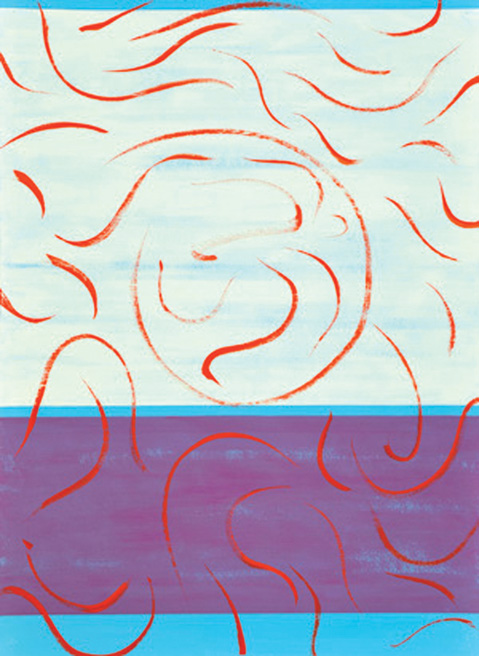Exhibit and Discussion at MichaelKate
Wayne J. Hoffman, Linda Saccoccio, and Pat Calonne
IMPANELED: On Friday, February 8, I entered the grand MichaelKate space over on Santa Barbara and Yanonali streets a little more nervous than normal; curator Brad Nack had recruited me to moderate a discussion among the three artists who are showing there through March 10. My anxiety had nothing to do with any lack of confidence in the quality of their work — I had been through the show with Nack the week before, and I was convinced that Linda Saccoccio, Wayne J. Hoffman, and Pat Calonne were all the real deal. On the contrary, what I was worried about was the fact that they were so good that there might not be much to say. Abstract art, even when it’s great, is notoriously difficult to talk about. Statements tend to slalom wildly between stupefyingly obvious praise — as in “he’s a good colorist” or “she has a great compositional sense” — and mind-numbingly pretentious theoretical analysis, as in “this work occupies the liminal space between being and abjection.”

To my surprise and delight, I had nothing to worry about. Hoffman, an affable engineer and a talented musician, was as easy to talk to as his work was easy to like. Years of teaching art in the adult education division of Santa Barbara City College (and, I suppose, decades of marriage and fatherhood) have left him intimately familiar not only with his own work but also with the dilemmas that all artists face. In response to a question about how long he expects viewers to need in order to take in the full significance of his paintings, which recall by turns the musicality of Kandinsky, the imagination of Klee, and the spirituality of Rothko, Hoffman said that however reconciled he was to requiring those long looks, he still aspires to a kind of instantaneous communication. In other words, no matter how well he paints, he’s always working to be better and more immediate.
For Saccoccio, a Rhode Island School of Design graduate and one-time resident of New York City, the route to her latest work, which recalls the lyrical freedom and color-savvy juxtapositions of Matisse, leads through myriad shifts in scale, medium, and technique. Her contributions to the panel were wide ranging, from detailed descriptions of her process to the marvelously broad advice to artists that it’s necessary to “embrace insanity” if you expect to make anything new. And her recent works are some of the most thrilling things yet exhibited at MichaelKate under the direction of Nack.
For Calonne, painting begins and ends (when it ends — she tends to return to things) with improvisations. Her delicious, resonant canvases recall the postmodern sprezzatura of Gerhard Richter, particularly in the way that she constantly experiments with the application of paint. Each of her works expresses something intangible, like memory, loss, or the passage of time, and does so through the accumulation of a palimpsest of gauzy, semitransparent layers of color. Operating in a “post-brush” environment, Calonne seizes on a mix of knives, trowels, kitchen tools, and cardboard to leave her complex, organic-seeming traces. Coming from a background as a psychotherapist, Calonne was perfectly positioned to sort through and ponder the many reflections on the creative process that surfaced during our discussion. “Sooner or later, if you are doing it right, you will encounter chaos,” she pronounced, leaving Hoffman to add that when you have done so, “it’s time to share the love.”
MORE DIALOGUE: “in direct dialogue” is the title of the excellent and timely new show of work by Joan Tanner now on view at Jane Deering Gallery (128 E. Canon Perdido St.). Tanner remains a great treasure and quite possibly our city’s greatest living artist. Do not miss either installment of this exhibition, which includes work dating back as far as the mid-1980s. It continues through March 2.



